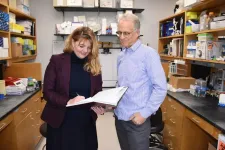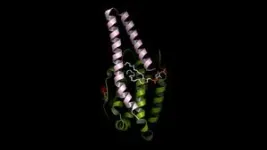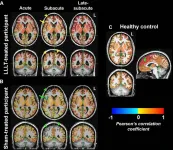(Press-News.org) PHILADELPHIA — (May 28, 2024) — The Wistar Institute’s Paul M. Lieberman, Ph.D., and lab team led by senior staff scientist and first author, Samantha Soldan, Ph.D., have demonstrated how B cells infected with the Epstein-Barr virus (EBV) can contribute to a pathogenic, inflammatory phenotype that contributes to multiple sclerosis (MS); the group has also shown how these problematic B cells can be selectively targeted in a way that reduces the damaging autoimmune response of multiple sclerosis. The lab’s findings were published in Nature Microbiology in the paper, “Multiple sclerosis patient derived spontaneous B cells have distinct EBV and host gene expression profiles in active disease.”
EBV — a usually inactive, or latent, herpesvirus — affects most of the human population; more than 90% of people carry the virus as a passive, typically symptomless infection. However, EBV infection has been linked to several diseases, including MS: an incurable, chronic autoimmune disease that causes the body’s immune system to attack the myelin sheath of neurons in the brain and nervous system. Because myelin sheathing facilitates fast nervous system signaling (the fatty insulation of myelin along a neuron’s axon allows electrical impulses to travel through neuronal networks faster), its degradation can cause a wide variety of symptoms in both type and severity that may include motor control disruption, sensory issues, and speech difficulties.
Though researchers know that EBV can contribute to the development of MS, the exact mechanisms by which it does so aren’t completely understood. The Lieberman lab, in seeking to understand how EBV contributes to the development of MS, collaborated with Steven Jacobson, Ph.D., of the Neuroimmunology Branch at the National Institute of Neurological Disorders and Stroke, who contributed cell line samples from patients. The research team analyzed spontaneous lymphoblastoid cell line (SLCL) cell samples from a healthy control group; a group of patients with active MS (as opposed to so-called stable MS; the disease is characterized by unpredictable periods of flare-ups and eased symptoms); and a group of patients with stable MS.
B cells are crucial cells of the immune system that help regulate the body’s immune responses; they have also been implicated in autoimmune conditions due to their role as mediators of which biological signals warrant immune response. And B cells, when infected with EBV, become immortalized — that is, the cells are no longer constrained by senescence, so they can continue to divide an indefinite number of times — as “lymphoblastoid cell lines,” or LCLs. This immortalized B cell state can occur spontaneously within the body as a result of EBV infection, which is how the Lieberman lab was able to extract immortalized SLCL samples for study from the different patient groups.
Having obtained the matched samples, Dr. Lieberman and his team conducted genetic analyses of the SLCLs and confirmed that the MS-positive sample groups showed greater expression of genes associated with lytic EBV (“lytic” describes when latent viruses like EBV become active); they also saw increased inflammatory signaling and expression of the FOXP1 protein, the latter of which was shown to promote lytic EBV gene expression. As a whole, the group’s findings suggested a mechanism of lytic EBV in MS that promoted inflammation and disease.
Diving further, Lieberman’s group tested several antiviral compounds on all SLCL groups and found that one, TAF, reduced lytic EBV gene expression without killing the cells. TAF also significantly reduced the expression of inflammatory cytokines like IL-6 in the SLCLs from the patients with active MS. Finally, when cultured SLCLs from active MS, stable MS, and controls were administered TAF in the presence of antiviral T cells, the T cell response (a major factor in the autoimmune dysfunction of MS) was reduced in SLCLs from patients with MS but not reduced in the control SLCLs — an indication that TAF treatment has potential as a selectively cytotoxic anti-lytic treatment for MS.
“Our work with these SLCLs shows that the problematic inflammation signaling from lytic EBV can be selectively targeted in a way that demonstrably reduces damaging immune responses,” said Dr. Lieberman. “We’re excited about expanding this concept further; we have the potential to see whether TAF or other inhibitors of EBV might be a viable treatment for multiple sclerosis that can stop the autoimmune damage without causing wide-ranging and dangerous cell death.”
Co-authors: Samantha S. Soldan, Chenhe Su, Leena Yoon, Toshitha Kannan, Urvi Zankharia, Rishi J. Patel, Jayaraju Dheekollu, Olga Vladimirova, Jack Dowling, Natalie Brown, Andrew Kossenkov, Daniel E. Schäffer, Noam Auslander, and Paul M. Lieberman of The Wistar Institute; Maria Chiara Monaco and Steven Jacobson of the Neuroimmunology Branch at the National Institute of Neurological Disorders and Stroke; Jack Dowling and Simon Thebault of the Perelman School of Medicine; Annaliese Clauze, Frances Andrada, and Joan Ohayon of the Neuroimmunology Clinic at the National Institute of Neurological Disorders and Stroke; and Andries Feder and Paul J. Planet of the Children’s Hospital of Philadelphia.
Work supported by: This work was supported by grants from the National Institutes of Health (R01 CA093606, R01 AI153508, R01DE017336 to PML, the Wistar Cancer Center Core Grant P30 CA010815), and the Department of Defense (HT9425-23-1-1049 Log#MS220073). The funders had no role in study design; data collection and analysis; decision to publish; or preparation of the manuscript.
Publication information: “Multiple sclerosis patient derived spontaneous B cells have distinct EBV and host gene expression profiles in active disease,” from Nature Microbiology
END
Wistar research identifies mechanisms for selective multiple sclerosis treatment strategy
Wistar’s Lieberman lab stopped inflammatory signaling and immune response in lab samples
2024-05-28
ELSE PRESS RELEASES FROM THIS DATE:
Fatherhood’s hidden heart health toll
2024-05-28
Among fathers, heart health was worse for men who became fathers under the age 25
First U.S. multiethnic longitudinal study to analyze cardiovascular health outcomes of fathers
Results differed by race and ethnicity subgroups
Age-adjusted rate of death for Black fathers was lower than for nonfathers
‘Fatherhood may be protective for Black men’
CHICAGO --- Heart disease is the leading cause of death among men, and being a father may put men at an even greater risk of poor heart health later in life, reports a new study from scientists at Northwestern University and Ann & ...
The importance of integrated therapies on cancer: Silibinin, an old and new molecule
2024-05-28
“This consideration could be the starting point to study whether Silibinin could contrast tumor progression, aging and inflammaging through molecular and cellular mechanisms [...].”
BUFFALO, NY- May 28, 2024 – A new review paper was published in Oncotarget's Volume 15 on May 23, 2024, entitled, “The importance of integrated therapies on cancer: Silibinin, an old and new molecule.”
In this new review, researchers Elisa Roca, Giuseppe Colloca, Fiorella Lombardo, Andrea Bellieni, Alessandra Cucinella, Giorgio Madonia, Licia Martinelli, Maria Elisa Damiani, Ilaria Zampieri, and ...
Texas A&M-led team creates first global map of seafloor biodiversity activity
2024-05-28
A pioneering study has used extensive global datasets and machine learning to map the activities of seafloor invertebrate animals, including worms, clams and shrimps, across the entire ocean, revealing for the first time critical factors that support and maintain the health of marine ecosystems.
The international team, led by Texas A&M University and including investigators from Yale University and the University of Southampton, specifically focused on the unsung yet vital role burrowing animals play as "ecosystem engineers" in shaping nutrient ...
Light therapy increases brain connectivity following injury
2024-05-28
OAK BROOK, Ill. – Low-level light therapy appears to affect healing in the brains of people who suffered significant brain injuries, according to a study published today in Radiology, a journal of the Radiological Society of North America (RSNA).
Lights of different wavelengths have been studied for years for their wound-healing properties. Researchers at Massachusetts General Hospital (MGH) conducted low-level light therapy on 38 patients who had suffered moderate traumatic brain injury, an injury to the head serious enough to alter cognition and/or be visible on a brain scan. Patients received ...
Power imbalance in health care reveals impact of race and role on team dynamics and DEI efforts
2024-05-28
Background and Goal: Team-based care is considered the gold standard in delivery models. It uses integrated clinical teams with diverse skills and perspectives to provide efficient, high-quality health care services. Within these teams, individuals from minoritized racial-ethnic groups, often referred to as persons of color (POC), typically occupy roles with less authority (e.g., medical assistants), while white individuals more frequently hold positions of greater power (e.g., physicians). Few studies have explored the viewpoints of staff members in lower-power roles, who are disproportionately POC and constitute the majority of a health care team. This study aims to ...
NRG Oncology appoints new vice-chairs for their patient advocate committee
2024-05-28
NRG Oncology (NRG), a National Cancer Institute (NCI) National Clinical Trials Network (NCTN) group focused on improving outcomes for adults with cancer through multi-center clinical research, recently announced two new Vice-Chairs to co-lead the NRG Patient Advocate Committee (PAC) alongside the current PAC Committee Chair, Dorothy Erlanger.
Marlyn Molero, was appointed as Vice-Chair of the NRG PAC. Marlyn is a clinical researcher in the oncology area with Commonspirit Research Institute as well as a Spanish interpreter at Vituity. Marlyn brings a unique perspective to the NRG PAC leadership ...
Why do Dyeing poison frogs tap dance?
2024-05-28
The toe tapping behavior of various amphibians has long attracted attention from researchers and pet owners. Despite being widely documented, the underlying functional role is poorly understood. In a new paper, researchers demonstrate that Dyeing poison frogs modulate their taps based on specific stimuli.
Dyeing poison frogs, Dendrobates tinctorius, have been shown to tap their posterior toes in response to a range of prey sizes, from small fruit flies to large crickets. In the present study, ...
UC Irvine study reveals circadian clock can be leveraged to enhance cancer immunotherapy
2024-05-28
Irvine, Calif., May 28, 2024 — A multidisciplinary research team at the University of California, Irvine has revealed that the circadian clock – the biological pacemaker that governs daily rhythms in physiological processes, including immune functions – can be leveraged to enhance the efficacy of checkpoint inhibitor cancer therapy. Checkpoint inhibitors block different proteins from binding to tumor cells, allowing the immune system’s T cells to kill the tumor.
The study, published online ...
Cell-targeting technology allows researchers to isolate neuronal subpopulations and link them to behavioral states
2024-05-28
(MEMPHIS, Tenn. – May 27, 2024) As gene sequencing technologies become more powerful, our understanding of cellular diversity has grown in parallel. This led scientists at St. Jude Children’s Research Hospital to create a tool to improve the ease and accuracy with which investigators can study specific subpopulations of cells. The tool, named Conditional Viral Expression by Ribozyme Guided Degradation (ConVERGD), allows researchers to specifically access these subgroups of cells and precisely manipulate ...
When should you neuter or spay your dog?
2024-05-28
Researchers at the University of California, Davis, have updated their guidelines on when to neuter 40 popular dog varieties by breed and sex. Their recent paper in Frontiers in Veterinary Science adds five breeds to a line of research that began in 2013 with a study that suggested that early neutering of golden retrievers puts them at increased risk of joint diseases and certain cancers.
That initial study set off a flurry of debate about the best age to neuter other popular breeds. Professors Lynette and Benjamin Hart of the School of Veterinary Medicine, the study’s lead authors, set out to add more breed studies by examining more than a decade ...
LAST 30 PRESS RELEASES:
Flour choice shapes sourdough microbial communities
Can a retinal implant reverse macular degeneration?
Feeding fungi plant remnants produces tasty protein to fortify vegan, vegetarian diets
New tech reduces false positives from breast ultrasounds
Drone-mounted lab monitors fertilizer runoff in real time
Short, light-intensity exercise boosts executive function and elevates mood in children
Jeonbuk National University researchers reveal new interface engineering strategy for efficient and stable back-contact solar cells
Tyrosinase drives hydroquinone-induced exogenous ochronosis: not HGD inhibition
UMass Amherst chemists develop unique tool for studying RNA
Disappointment alters brain chemistry and behavior
A built-in odometer: new study reveals how the brain measures distance
Stress-related brain signals drive risk of cardiovascular disease in people with depression and anxiety
New details on role of fat transport molecules in Alzheimer’s onset
Study illuminates how an antiviral defense mechanism may lead to Alzheimer’s disease
Spot the males: New gene-editing method could transform mosquito control
AI learns to build simple equations for complex systems
NAU team releases 13 years of detailed U.S. CO2 emissions data
Unveiling how sodium-ion batteries can charge faster than lithium-ion ones
How do childcare tax credits affect children’s long-term health?
Can an electronic nose detect indoor mold?
Do natural disasters have long-term impacts on mortality in older adults?
Modification improves sodium‐ion batteries as an alternative to lithium-ion batteries
Parasports provide a range of benefits for people with cerebral palsy
How does grandparental care affect children’s health?
Why are there so many Nordic mediators?
Young shark species more vulnerable to extinction
Mobile fetal heart monitoring linked to fewer newborn deaths in Tanzania
Bluey’s dad offered professorial chair in archaeology at Griffith University
Beyond small data limitations: Transfer learning-enabled framework for predicting mechanical properties of aluminum matrix composites
Unveiling non-thermal catalytic origin of direct current-promoted catalysis for energy-efficient transformation of greenhouse gases to valuable chemicals
[Press-News.org] Wistar research identifies mechanisms for selective multiple sclerosis treatment strategyWistar’s Lieberman lab stopped inflammatory signaling and immune response in lab samples







